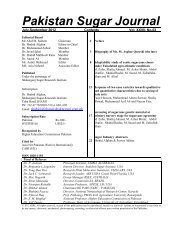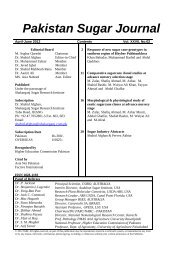Sep to Oct 2006 - Shakarganj
Sep to Oct 2006 - Shakarganj
Sep to Oct 2006 - Shakarganj
You also want an ePaper? Increase the reach of your titles
YUMPU automatically turns print PDFs into web optimized ePapers that Google loves.
PERFORMANCE OF IMPROVED GENOTYPES OF SUGARCANE ON FARMER’S FIELD<br />
IN BANNU NWFP<br />
By<br />
Khan Bahadar, M. Sadiq, Hamdullah Azim, Amin Ullah Khan and Sahibzada Obaidullah Jan*<br />
*Agricultural Research Station Serai Naurang, Bannu<br />
ABSTRACT<br />
The response of <strong>to</strong>tal twenty four improved genotypes of sugar cane was studied on farmer’s field<br />
at five different locations of Bannu division in plant/ra<strong>to</strong>on stages during 2003-04. Newly approved<br />
variety Bannu-Green (S84-I-282) exhibited the highest significant average cane yield of 125.23 t<br />
ha -1 with average sugar recovery of 10.81%, followed by variety SPF-238 producing average cane<br />
yield of 124.0 t ha -1 with average sugar recovery of 8.36% at single location. New varieties Bannu-<br />
3 and SPF-234 responded with maximum sugar recovery of 12.24 and 11.62% at another location.<br />
INTRODUCTION<br />
The role of sugarcane as valuable cash crop could never be ignored at farming and Industry Level.<br />
It is not only a major source of sugar production but also generates several by products for other<br />
industries and creates employment on farm, industry and trade levels. Sugar Industry is 2 nd <strong>to</strong><br />
textile in our country. Thus sugarcane provides vast agro industrial base which improves the<br />
national economy and saves great foreign exchange. It is known fact at under the prevailing<br />
challenging situations i.e. ever rising population, un-employment and WTO regime, improvement<br />
of such important commodity is highly emphasized. It plays vital role in the overall economy<br />
particularly poverty elevation in the area. The average cane yield of NWFP and district Bannu is<br />
46.27 and 40.41 t ha -1 (Anonymous, 2000), which is far below the average achievable yields (70-75<br />
t ha -1 ) under existing resources. Main causes for such poor yield are shortage of irrigation water<br />
and new suitable varieties in the area. Ahmad et al., (2003) are also of the opinion that sugarcane<br />
contributes <strong>to</strong> wider base of employment and national GNP. They concluded that lack of high<br />
yielding, disease free varieties are the main causes for poor yield of sugarcane. Makhdom et al.,<br />
(2001) also reported that lower yield of sugarcane (40-45 t ha -1 ) is due <strong>to</strong> poor varieties, agronomic<br />
and management fac<strong>to</strong>rs. Considering the basic need of farming community, trial were conducted<br />
on farmers fields at five different locations <strong>to</strong> evaluate most promising varieties under the<br />
prevailing conditions in the locality.<br />
MATERIAL AND METHODS<br />
The performance of twenty-four improved varieties of sugarcane was studied for cane yield and<br />
sugar contents on farmer field at five different locations in plant/ra<strong>to</strong>on stages during 2003-04. The<br />
trials were conducted in RCB design in three replications under plot size of 4.0 x 7.5 m with rows<br />
75 cm apart. The recommended and Basel dose of NP was applied @ 150-156 kg per hectare.<br />
Complete dose of P2O5 was applied at the time of seed beds preparations and nitrogen was applied<br />
in two equal doses during the month of May and June. Weedicide Gexapex Combi spray was<br />
performed @3.5 kg per hectare for the control of seasonal weeds in these trials during the month of<br />
February. Insectide Furadon granules were applied @ 20 kg per hectare in two equal doses during<br />
the month of May and June for the control of borer attack. Uniform cultural operations were<br />
adopted at appropriate stages in each trial. Data on cane yield and sugar recovery % were recorded<br />
at harvest stage. Data on cane yield were analyzed statistically using computer package MSTAT-C.<br />
8






